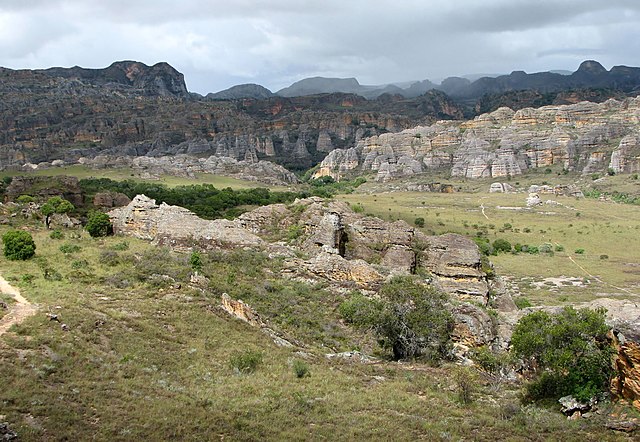
Isalo Park is a national park in Madagascar’s Ihorombe Region. It’s in the southwestern corner of the Fianarantsoa Province.
The closest town of this beautiful site is Ranohira. The closest cities are Toliara and Ihosy. Sandstone makes up the landscape.

Wind and water erosion have carved it into rocky outcrops, plateaus, and vast plains. This beautiful site has up to 200 m (660 ft) deep canyons.
You will find permanent rivers and streams with many seasonal watercourses. Elevation of this site varies between 510 and 1,268 m (1,673 and 4,160 ft).
More Information About Isalo Park
They created Isalo National Park in 1962. The Madagascar National Parks Authority has managed it since 1997. The Bara people traditionally lived in this area, relying on zebu farming.
The area includes burial sites of the Bara people and some older burial sites of the Sakalava. This great site is primarily within the dry deciduous forests ecoregion.
In this ecoregion, natural vegetation has abolished almost 40% of its original extent. Additionally, it includes landscapes considered part of the subhumid forests ecoregion.
Numerous endemic species call this area home. This ecoregion has a Critical/Endangered status. Only small areas of native habitat remain.
Most of those are highly fragmented. The endemic tree tapia dominates the woodlands of this site. This woodland type has a restricted distribution.
Madagascar’s central highlands are the only place where it is available. Some of the largest intact areas of Tapia woodlands are available on this site.
There are numerous narrowly endemic plant species found here. There are 13 species found only in this area and another 35 rare species, known from 2-5 sites.

Sarcolaenaceae is a plant family found only in Madagascar. Researchers have only found two species within it in Isalo NP. There are also unusual lichens here.
The endemic Isalonactis madagascariensis is the type specimen. It is the only known location for it. Isalo National Park is in the arid western part of Madagascar.
It is in the dry deciduous forest bioclimatic zone. The area has a hot, dry climate with two seasons. These seasons are cooler-drier seasons and a warmer, wetter season.
Each lasts 5–7 months. Temperatures in this region range between 15–32 °C. The average annual temperature is about 21.8 °C, and the average rainfall is 791 millimeters at Ranohira.
Precipitation is lowest in June, averaging 2 mm. The wettest month of this season is typically through December through February.
In January, rainfall averages in this area of Madagascar is about 199 mm. However, the 2018/2019 rainy season had heavy rain. In January alone, it reached about 526 mm.
The sedimentary Isalo Group is the geological formation of the park. The southern part of the Morondava Basin houses the Isalo Massif.
The group is up to 6,000m thick. It is of Triassic to early Jurassic origin. Coarse-grained sandstone makes it up. Braided streams deposited this sandstone.
Wind and water have eroded the Isalo Massif. Visitors to the park must hire a local guide in Ranohira. Guides and porters are available there.
Treks in this park can last from a few hours to a week or longer. The park includes several natural swimming pools, which are popular among tourists.
These sites are also majestic sites to observe Benson’s Rock Thrush. The threat to this fantastic site comes from illegal wildfires.
The wildfires of this place limit this beautiful forest and maximize grasslands used by cattle. Researchers report fourteen mammal species in this NP, including several lemur species.
Fauna and Flora of This Site
Researchers have found over 100 bird species here. These include Benson’s rock thrush, the knob-billed duck, and the Madagascar ibis.
Researchers have documented twenty-four amphibians and 47 reptiles in Isalo National Park. Several new candidate species are among them. Four amphibians are endemic to the Isalo area.
They are Gephyromantis azzurrae, Mantella expectata, Mantidactylus noralottae, and the Malagasy rainbow frog. There is also one reptile species, Trachylepis nancycoutuae.
The botanical inventory of this region began with collections by Perrier de la Bâthie in 1910. Non-native species create only 10 out of the 400 species documented in Isalo.
Most are vascular plants that are endemic to Madagascar. Researchers have found thirteen species only in Isalo. Another 35 are rare species, known from 2-5 sites.
Some entire plant families are only available in Madagascar. Three examples are in Isalo: Asteropeiaceae, Sarcolaenaceae, and Sphaerosepalaceae.
Sarcolaenaceae is a plant family found only in Madagascar. Two species, Sarcolaena isaloensis and Schizolaena isaloensis, are visible only in this NP.

The lichens of Madagascar are poorly known. Researchers have documented over 500 species. Only about 20 species are visible in the country’s dry areas.
Researchers have documented several of these in the Isalo area. They included the type specimen. It is also the only known location for the narrowly endemic Isalonactis madagascariensis.
- LAKE ITASY: A BEAUTIFUL SITE TO EXPLORE
- LAKE ANOSY: AN AMAZING AREA IN MADAGASCAR
- LAKE ALAOTRA: A BEAUTIFUL SPOT IN MADAGASCAR

A Bangladeshi entrepreneur. A person who loves nature, a web developer, and the founder of Srigal and Nehrin.